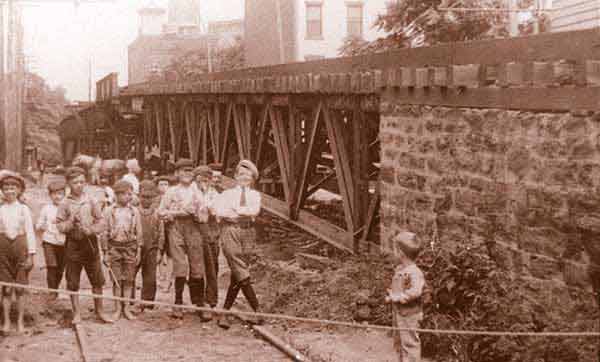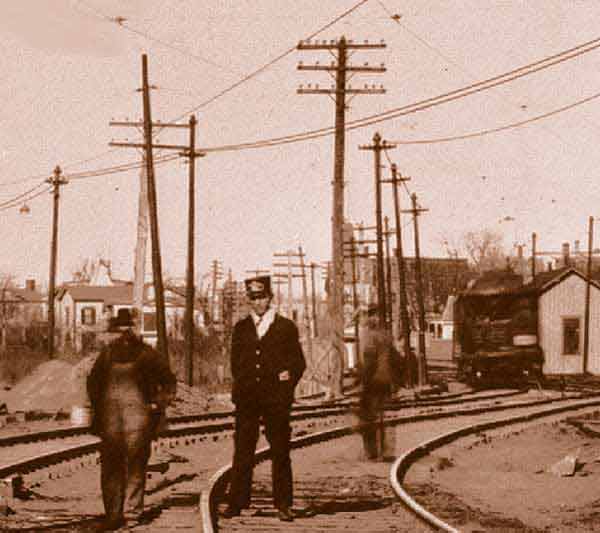rapidtransit.net
book commentary
The Malbone Street Wreck
by Brian Cudahy
Editor's Note: Even meticulous authors find errors of fact creeping into their work (including, of course, writings of your editor). Errors range from simple typos to gross distortions. In the case of The Malbone Street Wreck, Alan D. Glick has identified some errors which, while not impacting either the thread of the story or the author's conclusions, nevertheless are of interest to the rail historian and deserving of a hearing. Views expressed in signed reviews and commentary reflect the opinions of the author.
A Few Historical Errors in Cudahy's
The Malbone Street Wreck
Corporate Origin of the Brighton
Line
As soon as I received my eagerly anticipated
copy of The Malbone Street Wreck
by Cudahy in the mail, I locked myself in the bedroom and told my wife not
to disturb me till I had finished the book.
When I got to page 7, however, I was disturbed by an often
repeated error. In mentioning the incorporation date of the Brooklyn,
Flatbush and Coney Island Railway Company, Cudahy states it as being "June
25, 1869." The Brighton line was, however, actually incorporated in 1877,
one year before its opening. This mistake is one that has been repeated in
numerous sources. The earliest appearance of the error that I've found so
far is in Armbruster's "Coney Island" of 1924. The reason for this oft
repeated mistake is that there was another company of the same name that
was incorporated in 1869 (Actually this was the B,F&CI
Railroad Company, the Brighton line was the
B,F&CI Railway Company). The 1869
company had laid 6 miles of track by 1870 and was reorganized in 1878 as
The Brooklyn, Coney Island & Rockaway Railroad
Company.
To possibly confuse matters even
more, there was a third company with the same name that was incorporated
in 1866. This road however never saw any
construction.
All company documents and all
government agency documents cite the correct 1877 date. All books whose
primary topic is Brooklyn railroad history also cite the correct 1877
date. It is only in books that deal peripherally with transit history
that the incorrect date appears. This is why it is so surprising that
Cudahy repeats the mistake. To his credit, however, he does present the
correct date in a footnote which mentions another source that posits the
1877 date. The same footnote also correctly notes that the B,F,&CI
"may have" been formed by a consolidation of The Flatbush & Coney
Island Park and Concourse Railroad (1876), and The Coney Island and East
River Railroad (1876).
I've had this discussion before with
others and one of my favorite points was to mention how only non
railroad oriented books contained this error. Unfortunately the repetition of this error
in Cudahy's new book will add still more confusion to the
topic.
Opening Dates of Coney Island Excursion Roads
Length of Terminal and trackage
agreement between LIRR and BF&CI
The Brighton Line Connection to the Fulton
Street L
Brighton Beach Trains on Manhattan Beach Trackage The Age of Culver Depot
The chart on page 8
seems to have several incorect dates. The New
York and Manhattan Beach Line opened in 1877, not 1876. The West End Line
opened in 1864 as far as Bath, and to Coney Island in 1867. It was incorporated
in 1862, possibly the source of Cudahy's date.
Page 14
states "[...] on December 14, 1883, the [LIRR] evicted the Brooklyn,
Flatbush and Coney Island from its Brooklyn depot after five seasons of
service... and canceled the contract that permitted Brooklyn, Flatbush and
Coney Island trains to use Long Island's trackage." The closing date
is correct but the length of the arrangement was six years not five.
In the Brighton Line's first year of operation it signed a one year
agreement with the LIRR. When this expired an additional five year
agreement was signed. Also, an internal inconsistency occurs in the
book when Cudahy contradicts himself on page 55 by positing 1882 as the
year the agreement expired. This looks like a probable
typo.
Page 17 states that the
1896 connection to the Fulton El crossed the LIRR at grade. The ramp
actually started just north of Prospect Place. This left only two grade
crossings on the route to Fulton Street: at Park Place and at Prospect
Place. The ramp thus crossed over the LIRR at Atlantic Ave.
[See photo at bottom--Ed.]
Page 22 discusses
the rerouting of Brighton trains over the Manhattan Beach Line of the LIRR
during the grade crossing elimination project in the middle of the first
decade of the century.
Cudahy
states: "[...] exactly how this rerouting was effected remains unclear.
Possibly temporary trolley wire was strung over the Long Island Railroad
while construction was under way; perhaps BRT elevated trains were hauled
along the Long Island by steam engines." According to Seyfried trolley
wire was indeed set up over the LIRR to accomodate BRT electric trains.
[In fact, this is how rerouted trains were powered. See second photo
below--Ed.]![]()
![]()
![]()
![]()
On page 42 Cudahy talks
about the PP&CI depot that lasted until 1922. The book states,
"Culver Depot [built] in 1873 [...] was demolished in
1922." The first Culver Depot had to be replaced because of the
laying out of the new Surf Avenue. Seyfried says that, "In the
spring of 1883 a new station was built on the line of the new Surf Avenue
about 300 feet inland from the older station..." It is this station,
built in 1883, that was demolished in 1922. Even the BRT
Monthly, which Cudahy mentions
in the relevant footnote, makes this mistake. The magazine, while probably reliable for
contemporaneous events, obviously didn't put that much work into researching its own
history. 
Boys in the 'Hood, 1904 Style. Some local
kids pose for the photographer adjacent to the Brighton Line's steel and
masonry ramp connecting it to the Fulton Street L. This view is on the
west side of the structure looking north. Prospect Place is at the
photographer's back while some horse-powered transportation passes under
the structure on St. Mark's in the background. Atlantic Avenue and the
Fulton L connection are several blocks further north.
Paul Matus Collection
A
BRT Conductor, natty in his uniform, poses near a
pair of workers as a Coney Island-bound Brighton train returns to the
Brighton Line on the temporary track connecting the LIRR Manhattan Beach
Line with the Brighton Line below Sheepshead Bay station. Trolley wire
shows clearly in this view, looking north toward the LIRR right-of-way.
The train must have been stopped or nearly so, as the workers' forms are
blurred in this time exposure. Paul Matus
Collection.
Return to Book Review
Home
Return to rapidtransit.net Home
Everything on this site is copyright 1999 by The Composing Stack
Inc., except as otherwise noted.
Materials with other copyrights are
used by permission.
All rights reserved
Last updated October 14, 1999